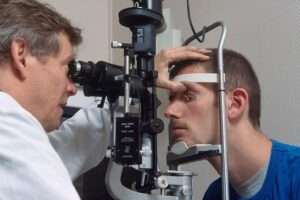Kearns-Sayre syndrome (KSS)
Kearns-Sayre syndrome (KSS) is a rare condition that affects the body. KSS impacts muscles, eyes, and the heart. The disorder is complex, with symptoms like muscle weakness, vision issues, and irregular heartbeats. It arises from mutations in mitochondrial DNA, which disrupt energy production. Mitochondria are tiny structures inside cells that produce energy for the body’s functions. Disrupted energy production from mutated mitochondrial DNA causes widespread problems in KSS.
Prevention of Kearns-Sayre Syndrome

Kearns-Sayre syndrome (KSS) cannot currently be prevented. It results from genetic mutations in mitochondrial DNA. However, some steps may help manage complications. These include preventive care and strategies to enhance life quality. Individuals with KSS and healthcare providers should collaborate on these approaches.
- Regular Medical Monitoring: Medical checkups for KSS patients are vital. A team of healthcare experts monitors disease progress, handles complications, and gives care. Checkups happen regularly.
- Healthy Lifestyle Practices: Maintain a healthy lifestyle – balanced meals, regular exercise suited to abilities, avoiding smoking and excessive drinking. This supports overall well-being for those with KSS.
- Genetic Counseling and Family Planning: Genetic counseling supports families affected by KSS. It explains inheritance patterns, family planning options, and available resources. Counseling provides valuable info and guidance.
- Adaptive Devices and Supportive Care: Enabling independence and enhancing life quality, adaptive tools and supportive measures like mobility aids, assistive devices, and home adjustments can prove invaluable for individuals navigating KSS.
- Participation in Research Studies: Contributing to scientific progress and potentially unlocking novel treatment avenues, participating in clinical trials or research studies not only offers a chance to access experimental interventions but also furthers our collective comprehension of KSS.
What organelle is affected by kearns-sayre syndrome?
Kearns-Sayre syndrome (KSS) impacts a minuscule structure within our cells, the mitochondria. These are powerhouses generating energy for cellular function. With KSS, issues arise with the mitochondrial DNA, disrupting efficient energy production.
History of Kearns-Sayre Syndrome
People first learned about Kearns-Sayre Syndrome in 1958. Dr. Thomas Kearns and Dr. George Sayre were eye doctors. They observed patients with similar health issues. Since then, experts have gained much knowledge. They better understand what causes KSS. They’ve improved how to identify and treat it.
- Pioneering Discoveries: In an important paper named “Retinitis Pigmentosa, External Ophthalmoplegia, and Complete Heart Block,” Dr. Kearns and Dr. Sayre outlined key features of KSS. They found KSS causes eye issues, muscle weakness around the eyes, and heart problems.
- Advancements in Research: As research advanced over time, scientists learned more about KSS’s genetic causes and how mitochondria are involved. They pinpointed DNA mutations linked to KSS. This knowledge helps find possible treatments for the condition.
Prognosis of Kearns-Sayre Syndrome

The outlook for Kearns-Sayre Syndrome differs greatly. It relies on the intensity of symptoms and complications present. While KSS progresses, affecting various body systems, individuals with proper medical care and assistance can lead fulfilling lives.
- Factors Influencing Prognosis: Factors like muscle weakness level, heart issues, and other complications like breathing or hormonal problems can change the KSS outlook. The worse these problems, the harder the journey could be.
- Life Expectancy: While some KSS cases limit lifespan, many people can reach adulthood and beyond with good care. But monitoring health issues and treating complications is key to better outcomes and living well.
- Quality of Life Considerations: Living well despite KSS challenges is possible with help from doctors, loved ones, and resources. Special tools, tech aids, and supportive care aid independence and daily living for those affected.
Kearns-Sayre syndrome life expectancy
Kearns-Sayre Syndrome’s effect on life span differs. It depends on symptom intensity and complications present. Though serious, impacting health and quality, proper care allows many KSS individuals adulthood longevity. However, certain severe symptoms and complications reduce lifespan expectancy in some cases. The condition’s varying severity determines this variable life expectancy outcome.
How is kearns-sayre syndrome inherited?
Kearns-Sayre syndrome is not typically inherited in the traditional way from parents. The mutations mostly happen spontaneously during development, not passed down through genes. However, there’s a small chance (about 1 in 24) that a mother can pass a mutated form of mitochondrial DNA to her child.
Is Kearns-sayre syndrome deadly?
Kearns-Sayre Syndrome can be a difficult condition. But it doesn’t always have to be fatal. KSS can lead to issues affecting different parts of the body. However, with medical care and help, many people with KSS can live quite long lives. Still, some severe problems like irregular heartbeats or breathing troubles can be very risky. These complications may affect how long someone with KSS lives.
Kearns-sayre syndrome pronunciation
Kearns-Sayre Syndrome is pronounced as “keerz-sair” syndrome.
Kearns-sayre syndrome ketones
Kearns-Sayre Syndrome has nothing to do with ketones directly. Ketones get made by the liver when fat breaks down for energy. This happens when you don’t eat carbs or during fasting periods. Even though KSS involves mitochondrial issues that affect metabolism, the condition itself doesn’t influence ketone production specifically.
Case Studies and Patient Experiences
Case 1: Sarah’s Journey
Sarah, diagnosed with KSS at 10, initially struggled with vision loss and fatigue. Early intervention with eye care and physical therapy helped her manage these symptoms. As a young adult, Sarah experiences some heart rhythm issues, but medication keeps them under control. She leads an active life, works part-time, and enjoys spending time with friends and family.
Case 2: Michael’s Story
Michael’s KSS primarily affects his heart. Diagnosed in his teens, he relies on a pacemaker to regulate his heartbeat. While muscle weakness limits strenuous activities, physical therapy helps him maintain mobility. Michael excels in computer science studies and finds a fulfilling career path that accommodates his limitations
